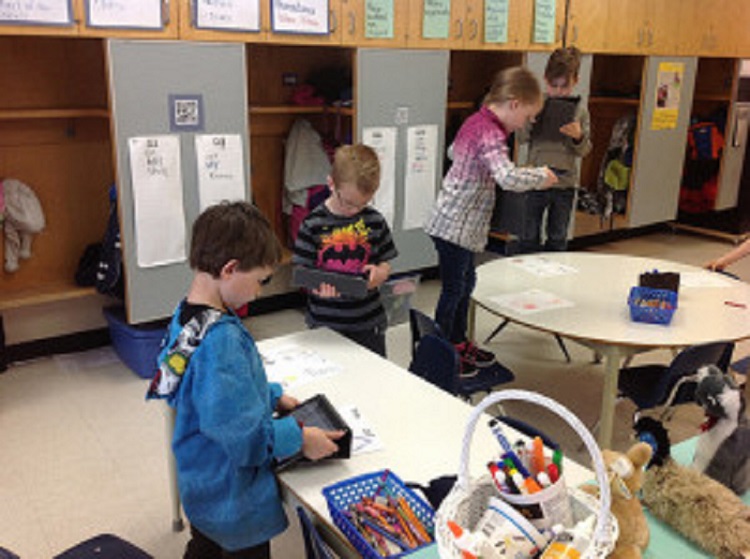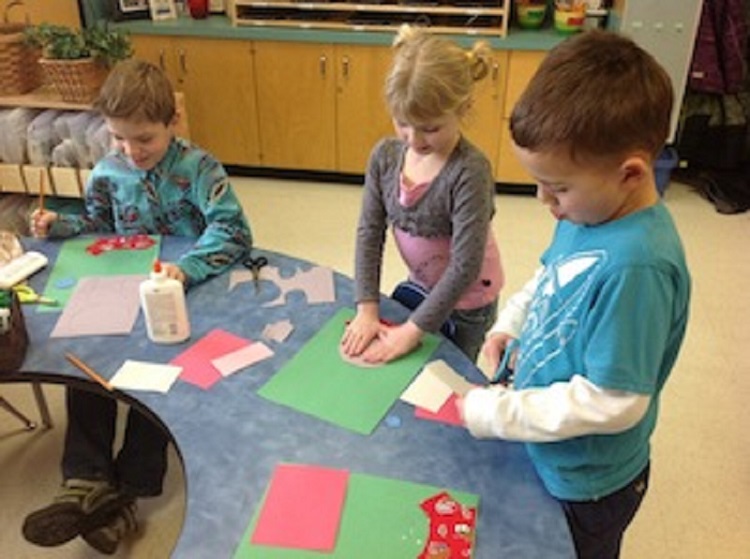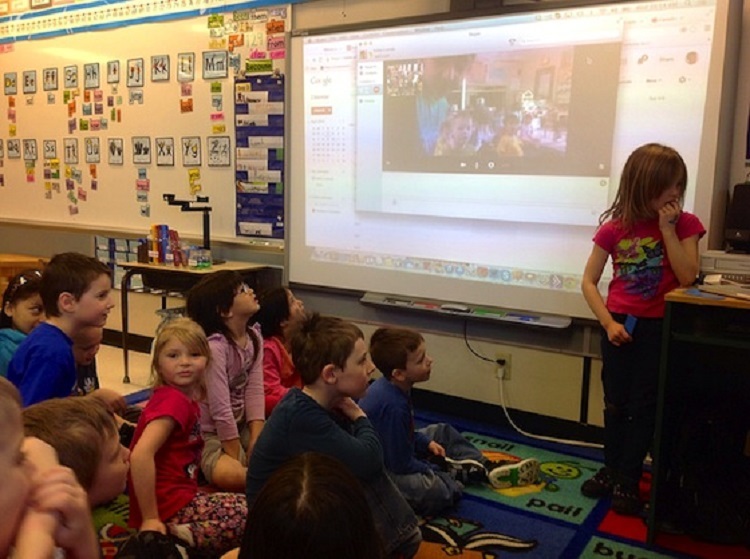by Kathy Cassidy
I frequently get emails from primary teachers asking for help as they begin to add technology in their classroom. These teachers have a lot of questions. They want to use technology, but there always seem to be problems or glitches of some kind along the way.
Their emails go something like this: “How do you use technology so easily in your classroom? It seems to run so well for you. What is your secret? How does that happen? There are always problems when I use technology and then I want to give up.”
These are all great questions. I too have experienced many bumps in my travels with technology. Just when the journey seems to be becoming smoother, another roadblock comes along that needs to be negotiated. Experience has taught me a few things about the mindset that helps us navigate this bumpy road.
Don’t just “integrate” technology
The first bump in the technology road involves a new way of thinking. Don’t view technology in the classroom as just one more thing to add to your day. And if “integrate” means (as it often does) adding one more thing to your already heavy load, then we probably need a better word. Technology should help us to teach better and in more meaningful ways. It should be used to connect us. It should give us choice and allow us to share. It should not be something that you do in addition to everything else you already do in your classroom. If technology is something that you try to add after you have planned your reading, writing and math, you are destined to fail at “integrating” technology.
Using technology in the classroom does not mean keeping your students entertained with digital worksheets, or practicing skills with animation, or using computer time instead of a red checkmark as a reward. Instead, use technology when it allows you to do something in a better way than you have done before or to do something that was formerly impossible to do.
Technology supports new ways of learning
Thanks to advances in technology, we now have powerful tools to help students understand and learn in unique ways.
You can select a tool or app that will give your students an online audience for their learning and connect them with other classrooms and experts around the world. That tool may be as different as a classroom blog or Twitter or Skype. Other tools make it easy for your students to create artifacts that show not just their learning, but their thinking processes and their self reflections. These are all examples of doing things with technology that could not be done before.
Use technology to make learning new and different in your classroom. Set your sights high and aim for activities that transform! Then, when you hit a bump, you will be more motivated to keep trying. Transformation is never smooth.
Expect problems
My days with technology do NOT all run smoothly. Sometimes there are many stops and starts. This is especially true at the beginning of the school year as my six year olds become familiar with the tools and apps we will use to learn and share what we know. Bandwidth can be an issue in my school, and access has often been as well. Sometimes a tool that I rely on will not work for some reason or other.
I think that everyone experiences these issues and they can be very frustrating. On the other hand, things don’t always run smoothly when I am teaching without technology either.
When my students use pencils, they frequently break and need to be sharpened. Some of the children chew on the ends of the shared pencils we use. Erasers get thrown, children get poked. My students hold their pencils in a wide variety of ways, many of which need to be patiently corrected. But we don’t stop using pencils and erasers. I continue modeling the correct usage of those tools and helping students practice until they can use them well.
I don’t let the rough spots deter me because I know the importance of students learning how to use these and other traditional tools to assist and demonstrate their learning. The same holds true when we use a form of technology. Children already know how to use technology for entertainment. They need to learn how technology can help them to learn.
What is the solution? For anything that will become a learning routine in my early years classroom, whether it involves technology or not, I model, model, model it and then we practice it together until the students can do it independently. Even once that independence has been established, I still have to monitor how and what the children are doing to ensure the best learning outcomes.
Flexibility and a backup plan are important ingredients in any classroom, but particularly in a space that includes the use of technology. If the Internet goes down in the middle of our day, I have to be prepared to teach another way, just as if I had planned a trip to the school library and it was suddenly unavailable.
Start with just one thing
My suggestion for people who are hesitant to use technology in significant ways is to start with one thing. Think of one way technology could enhance or deepen the learning in your classroom and then just try it. If you fumble and falter for a bit, keep trying. Like the six year old learning to hold a pencil properly, you will gain mastery over time.
It’s easy to become overwhelmed if you try too many different tools at once. Most of us who have been teaching with technology for awhile have taken on too much too fast somewhere along our journey. Focus on just that one technology-enhanced activity until you feel very comfortable with it. Then, when that feels good, try adding something else.
Maybe you would like to share what is happening in your classroom with your students’ parents and others who are part of your classroom community. Why not try a classroom blog, a classroom Twitter account or a Facebook page to showcase the activities and learning that are taking place? (You don’t have to do all three at once!)
Perhaps you would like your students to be able to publish their writing or their reading fluency or their math skills for a global audience. If this is the case, then why not try student blogs or some other online program? Invite others in to view and give feedback to your learners.
Maybe you would like to use Skype to connect your classroom with another classroom far away to compare perspectives. Check out the resources that are available to help you do this. Plan a small event, perhaps with another teacher who is also just beginning to use Skype. Learn together. Building a network of online support is a great way to bolster your confidence
It’s not technology – it’s the stuff of teaching
What do you consider to be technology? A pencil? An overhead projector? A computer? An iPod device? At some point, each of these items was considered to be the very latest technology for the classroom.
Many people think of technology as anything that came into popular use after they reached adulthood. To my six-year-old students, and in fact to all students in school today, computers, tablets, smart phones, interactive boards, etc. are not technology. They just are. It’s their teachers and parents who consider these items to be something new or unusual
students are comfortable using these devices to communicate and to find information. To them, tools and apps are just another part of the world they inhabit. These tools have the power to become the stuff of teaching and learning if we will let them. Don’t think of them as technology. They are just part of the fabric of life around us. Students need to be shown how to use them to learn.
Is using technology bumpy? You bet. But we need to begin thinking the way our children do. We use technology not just because it is technology, but because of what it can do. It engages us and helps us to learn. So bring on the bumps!
The original version of this post, written by Kathy Cassidy, appeared in this blog in January of 2014. Kathy is the author of Connected From the Start: Global Learning in the Primary Grades, published by Powerful Learning Press, which is now being given away for free on her blog.
Kathy Cassidy
Latest posts by Kathy Cassidy (see all)
- Technology in the Classroom: Embrace the Bumpy Ride! - March 21, 2019
- Passion Based Learning (PBL) in Primary: Making Up the Rules - March 13, 2019
- Passion Based Learning (PBL) in the Primary Grades: Who Asks the Questions? - February 17, 2019






Sometimes jumping in and trying something out (the old trial and error method) is the best way to deal with technology. As you get deeper into it, you learn to anticipate some potential problems along the way. Thinking of all tools as technology, whether they’re online, digitial, or otherwise, is really important. We need to change our mindset before we can feel comfortable teaching with technology.
Well said, Elisa. I couldn’t agree more.
As I like to say, “Smile and pretend it’s part of the lesson plan!”
🙂 And ask, “How could we solve this?” I love the way you think.
Agreed (on both accounts). Expect problems, be flexible, and go into problem solving mode. I love it when students jump in and suggest solutions! It’s easy to freak out and get frustrated but it can quickly become a learning environment all around – creative problem solving, patiences, and coming up with plan b, c, and d when the first one (or three) doesn’t work out! Sounds a lot like real life 🙂
An excellent, timely piece. Meaningful learning experiences are essential . Our mindset is very important, coupled with seeing through a lens that acknowledges the invisible. Watching our primary students sharing their learning last week, I am ever amazed by the ease with which they seamlessly connect their device , deal with problems and confidently present. It’s time to begin learning alongside ones students. Love the pencil reference. Thanks
A really good read and I agree it takes time for some staff to get onboard. I watched a lecture @Bett2014 from the pioneers of The Flipped Classroom. Technology is a massive part of my classroom and it was great to hear that I’m on the right tracks when flipping my classroom. We’re now spending more time on the higher order thinking parts of Blooms.
Terrific post, Kathy. I plan on sharing this with my K-5 staff. “Start with just one thing” is sage advice when embedding technology into our daily instruction. Once we build fluency with using a certain tool, it ceases to become one more thing to do, and instead becomes how we do things here.
Thanks again for what you share, great stuff.
I thought this was a very interesting point. There is a lot of debate about whether or not to use technology in the classroom, I personally think that it has its benefits. Technology encourages students to use resources to learn material and possibly go outside their comfort zone in order to find out information. A lot of teachers might get overwhelmed by using technology in their classroom, but they can start off by doing one technology-enhanced activity until they’re comfortable and then going from there. It is also a great way to stay connected with parents or other community members, such as, having a classroom blog like you. Technology also helps students understand that technology doesn’t just take place inside the classroom. By surfing the web, students can revisit material that was covered in class and even use it for their own educational purposes, such as, starting their own blog. By incorporating technology into the classroom, it encourages students to practice independent learning.
It’s great to see you are thinking about this, Tracy! Our students ARE growing up in a digital world and sticking our heads in the sand and avoiding technology will not change that.